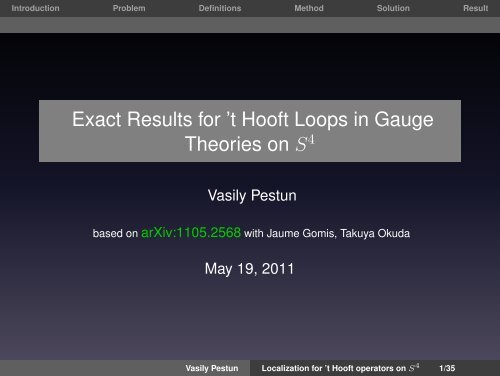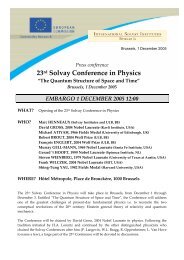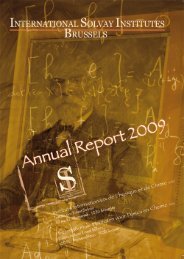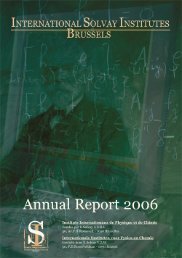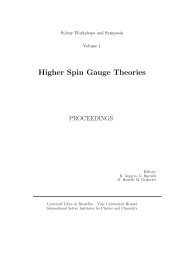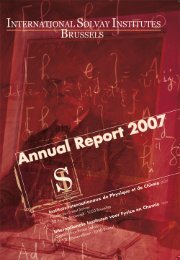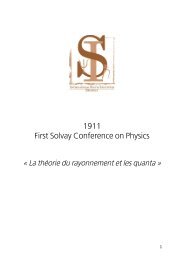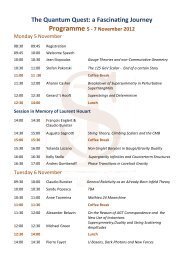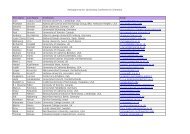Exact Results for 't Hooft Loops in Gauge Theories ... - Solvay Institutes
Exact Results for 't Hooft Loops in Gauge Theories ... - Solvay Institutes
Exact Results for 't Hooft Loops in Gauge Theories ... - Solvay Institutes
Create successful ePaper yourself
Turn your PDF publications into a flip-book with our unique Google optimized e-Paper software.
Introduction Problem Def<strong>in</strong>itions Method Solution Result<br />
<strong>Exact</strong> <strong>Results</strong> <strong>for</strong> ’t <strong>Hooft</strong> <strong>Loops</strong> <strong>in</strong> <strong>Gauge</strong><br />
<strong>Theories</strong> on S 4<br />
Vasily Pestun<br />
based on arXiv:1105.2568 with Jaume Gomis, Takuya Okuda<br />
May 19, 2011<br />
Vasily Pestun Localization <strong>for</strong> ’t <strong>Hooft</strong> operators on S 4 1/35
Introduction Problem Def<strong>in</strong>itions Method Solution Result<br />
Supersymmetry is a powerful tool to address dynamics of<br />
gauge theories<br />
• The N = 2 effective low energy Seiberg-Witten theory<br />
• Maldacena’s conjecture on the AdS/CFT correspondence<br />
<strong>for</strong> N = 4 SYM<br />
Vasily Pestun Localization <strong>for</strong> ’t <strong>Hooft</strong> operators on S 4 2/35
Introduction Problem Def<strong>in</strong>itions Method Solution Result<br />
Loop operators are important gauge theory observables.<br />
Wilson loop operator measures effective <strong>for</strong>ces between<br />
quarks.<br />
(locally) supersymmetric Wilson loop operator was the key<br />
object <strong>in</strong> several AdS/CFT studies <strong>for</strong> N = 4 SYM<br />
• [Erickson-Semenoff-Zarembo] and [Drukker-Gross] circular<br />
1/2 BPS Wilson loops <strong>in</strong> N = 4 SYM<br />
• [Alday-Maldacena] polygonal Wilson loops and amplitudes<br />
<strong>in</strong> N = 4 SYM<br />
At λ → ∞, Wilson loop C ⊂ R 4 is dual to the m<strong>in</strong>imal surface <strong>in</strong><br />
AdS land<strong>in</strong>g on C ⊂ R 4<br />
Vasily Pestun Localization <strong>for</strong> ’t <strong>Hooft</strong> operators on S 4 3/35
Introduction Problem Def<strong>in</strong>itions Method Solution Result<br />
Motivation<br />
Why we look on supersymmetric loops <strong>in</strong> N = 2 theories?<br />
• What from N = 4 SYM can be pushed to N = 2?<br />
• How S-duality acts? Can we compute vevs of Wilson and ’t<br />
<strong>Hooft</strong> and test S-duality precisely?<br />
• The loop observables <strong>in</strong> N = 2 theories are novel - not<br />
computable from Seiberg-Witten theory - hence we’ll learn<br />
someth<strong>in</strong>g new about N = 2 dynamics if compute them<br />
Vasily Pestun Localization <strong>for</strong> ’t <strong>Hooft</strong> operators on S 4 4/35
Introduction Problem Def<strong>in</strong>itions Method Solution Result<br />
Wilson operators<br />
1. Def<strong>in</strong>e N = 2 theory on S 4 of radius r.<br />
2. Localize the path <strong>in</strong>tegral and get [V.P.’07]<br />
〈W R (C)〉 S 4 = 1 ∫<br />
[da]|Z Ω (ia, ɛ 1 , ɛ 2 , m, τ)| 2 tr R e 2πiar<br />
Z S 4<br />
Z Ω – Nekrasov’s partition function of N = 2 twisted theory on<br />
R 4 ɛ 1 ,ɛ 2<br />
[Losev-Moore-Nekrasov-Shatashvili’95,Nekrasov’02]<br />
ɛ 1 = ɛ 2 = 1/r<br />
Vasily Pestun Localization <strong>for</strong> ’t <strong>Hooft</strong> operators on S 4 5/35
Introduction Problem Def<strong>in</strong>itions Method Solution Result<br />
Problem<br />
Compute exact vev of supersymmetric ’t <strong>Hooft</strong> operator <strong>in</strong><br />
N = 2 gauge theories<br />
Vasily Pestun Localization <strong>for</strong> ’t <strong>Hooft</strong> operators on S 4 6/35
Introduction Problem Def<strong>in</strong>itions Method Solution Result<br />
Def<strong>in</strong>itions<br />
Def<strong>in</strong>e the N = 2 supersymmetry on S 4 : OSp(2|4) ⊂ SL(1|2, H)<br />
— subgroup of the N = 2 supercon<strong>for</strong>mal group with<br />
• 8 fermionic generators<br />
• Sp(4) ≃ SO(5) bosonic subgroup – isometry of S 4<br />
• SO(2) R symmetry<br />
All zero modes <strong>in</strong> the OSp(2|4) theory on S 4 are lifted. We<br />
<strong>in</strong>tegrate over all fields <strong>in</strong> the path <strong>in</strong>tegral. No moduli on S 4 .<br />
Vasily Pestun Localization <strong>for</strong> ’t <strong>Hooft</strong> operators on S 4 7/35
Introduction Problem Def<strong>in</strong>itions Method Solution Result<br />
To <strong>in</strong>troduce hypermultiplet masses <strong>in</strong> OSp(2|4) theory on S 4 :<br />
1 gauge the flavor symmetry<br />
2 give expectation value to Φ 0 <strong>in</strong> the flavor vector multiplet<br />
Remark on our conventions<br />
In the OSp(2|4) theory on S 4<br />
• m is real <strong>for</strong> positivity of the action<br />
• <strong>in</strong> con<strong>for</strong>mal theory m = 0<br />
• under localization m relates to Ω-background m Ω of<br />
[Nekrasov’02] as<br />
m Ω = ɛ 1 + ɛ 2<br />
2<br />
+ im<br />
The usual complex scalar field <strong>in</strong> N = 2 vector multiplet on R 4<br />
corresponds to a pair of real fields on S 4 : Φ 0 and Φ 9 .<br />
Vasily Pestun Localization <strong>for</strong> ’t <strong>Hooft</strong> operators on S 4 8/35
Introduction Problem Def<strong>in</strong>itions Method Solution Result<br />
Supersymmetric Wilson loop<br />
∮<br />
W R (C) = tr R Pexp (Adx + iΦ 0 ds)<br />
Supersymmetric ’t <strong>Hooft</strong> loop<br />
Specify asymptotics <strong>in</strong> local R 3 normal to the loop (x = 0):<br />
F A → − ⋆ B dx<br />
2 x 2 , x → 0<br />
Φ 9 → B 1<br />
2 x , x → 0<br />
The parameter is B ∈ g (weight of ∨ G) def<strong>in</strong><strong>in</strong>g homomorphism<br />
U(1) → G.<br />
The asymptotics locally satisfies Bogomolny equations<br />
C<br />
D A Φ 9 = ⋆F A<br />
Vasily Pestun Localization <strong>for</strong> ’t <strong>Hooft</strong> operators on S 4 9/35
Introduction Problem Def<strong>in</strong>itions Method Solution Result<br />
Method: Localization Pr<strong>in</strong>ciple<br />
Localize the path <strong>in</strong>tegral:<br />
∫<br />
Z 0 = [Dφ] e −S 0[φ]<br />
S 0 – the physical action<br />
Q – global fermionic symmetry, QS 0 = 0<br />
Q 2 = R – global bosonic symmetry<br />
De<strong>for</strong>m the action<br />
assum<strong>in</strong>g {Q 2 , V } = 0<br />
S t [φ] = S 0 [φ] + t{Q, V }<br />
Vasily Pestun Localization <strong>for</strong> ’t <strong>Hooft</strong> operators on S 4 10/35
Introduction Problem Def<strong>in</strong>itions Method Solution Result<br />
Now consider<br />
Integrat<strong>in</strong>g by parts we get<br />
∫<br />
Z t = [Dφ] e −S 0[φ]−t{Q,V [φ]}<br />
d<br />
dt Z t = 0 =⇒ Z 0 = Z ∞<br />
At t = ∞ the one-loop approximation to Z t is exact. But<br />
Z t = Z 0 . Hence we get exact Z 0 .<br />
Vasily Pestun Localization <strong>for</strong> ’t <strong>Hooft</strong> operators on S 4 11/35
Introduction Problem Def<strong>in</strong>itions Method Solution Result<br />
We often take V = (Ψ, QΨ), where Ψ are the fermions of the<br />
theory.<br />
The path <strong>in</strong>tegral with action<br />
S t = S 0 + tQV<br />
and V = (Ψ, QΨ) localizes to configurations<br />
QΨ = 0<br />
Vasily Pestun Localization <strong>for</strong> ’t <strong>Hooft</strong> operators on S 4 12/35
Introduction Problem Def<strong>in</strong>itions Method Solution Result<br />
∫<br />
Z =<br />
X<br />
Localization summary<br />
e −S = ∑ ∫<br />
e −S| Yα Z1−loop [N Yα ]<br />
α Y α⊂X<br />
where:<br />
Q is a fermionic symmetry<br />
Q 2 = R is a bosonic symmetry<br />
QS = 0<br />
X = {Φ} is a space of fields<br />
Y α = {Φ|QΨ = 0} are components of the localization locus<br />
N Yα - normal bundle to Y α ⊂ X.<br />
Vasily Pestun Localization <strong>for</strong> ’t <strong>Hooft</strong> operators on S 4 13/35
Introduction Problem Def<strong>in</strong>itions Method Solution Result<br />
Solution strategy<br />
We need to localize the path <strong>in</strong>tegral of N = 2 gauge theory on<br />
S 4 <strong>in</strong> the presence of ’t <strong>Hooft</strong> s<strong>in</strong>gularity.<br />
0 Def<strong>in</strong>e the action S, the t’ <strong>Hooft</strong> operator T and the<br />
fermionic operator Q compatible with S and T<br />
1 F<strong>in</strong>d the localization loci Y α (solve QΨ = 0).<br />
2 Compute exp(−S| Yα )<br />
3 Compute the determ<strong>in</strong>ant Z 1−loop [N Yα ]<br />
4 Integrate over Y α and sum over α<br />
Vasily Pestun Localization <strong>for</strong> ’t <strong>Hooft</strong> operators on S 4 14/35
Introduction Problem Def<strong>in</strong>itions Method Solution Result<br />
Step 0. The Q.<br />
The Q is def<strong>in</strong>ed by a con<strong>for</strong>mal Kill<strong>in</strong>g sp<strong>in</strong>or ε on S 4<br />
∇ µ ε = Γ µ˜ε<br />
In the R 4 con<strong>for</strong>mal frame generic ε is<br />
ε = ˆε s + x µ Γ µˆε c<br />
We choose certa<strong>in</strong> ε s (chiral right) and ε c (chiral right) and fix<br />
Q = Q ε such that<br />
Q 2 = J + R<br />
where J is a self-dual rotation of S 4 and R is R-symmery <strong>in</strong><br />
OSp(2|4)<br />
North pole x = 0, ε is chiral right<br />
South pole x = ∞, ε is chiral left<br />
Vasily Pestun Localization <strong>for</strong> ’t <strong>Hooft</strong> operators on S 4 15/35
Introduction Problem Def<strong>in</strong>itions Method Solution Result<br />
Step 1<br />
The equations are QΨ = 0, where<br />
QΨ = 1 2 F mnΓ mn ε − 1 2 φ aΓ aµ ∇ µ ε + iK i Γ 8i+4 ε<br />
For our Q, the equations <strong>in</strong>terpolate between<br />
• north pole: <strong>in</strong>stanton equations F + = 0 and DΦ 9 = 0<br />
• equator: Bogomolny equations DΦ 9 = ∗F <strong>in</strong> the space<br />
transversal to the S 1 orbits and <strong>in</strong>variance along S 1<br />
• south pole: anti-<strong>in</strong>stanton equations F − = 0 and DΦ 9 = 0.<br />
Vasily Pestun Localization <strong>for</strong> ’t <strong>Hooft</strong> operators on S 4 16/35
Introduction Problem Def<strong>in</strong>itions Method Solution Result<br />
Technical details:<br />
Convenient coord<strong>in</strong>ates<br />
S 4 = S 1 × B 3<br />
where B 3 is a 3d solid ball with a boundary B 3 : ∑ 3<br />
i=1 x2 i < 1<br />
and S 1 is a circle τ<br />
The round S 4 metric is<br />
ds 2 =<br />
dx 2 i<br />
(1 + x 2 ) 2 + (1 − x2 ) 2<br />
(1 + x 2 ) 2 dτ 2<br />
B 3 -flat rescaled metric<br />
ds 2 = dx 2 i + (1 − x 2 ) 2 dτ 2<br />
The ’t <strong>Hooft</strong> loop is the S 1 fiber at x i = 0.<br />
The North pole, the first fixed po<strong>in</strong>t of Q 2 is x = (0, 0, 1)<br />
he South pole, the second fixed of Q 2 is x = (0, 0, −1)<br />
Vasily Pestun Localization <strong>for</strong> ’t <strong>Hooft</strong> operators on S 4 17/35
Introduction Problem Def<strong>in</strong>itions Method Solution Result<br />
In coord<strong>in</strong>ates (x i , τ) the equations <strong>for</strong> vector multiplet are<br />
[<br />
F 1τ + D 1 , i (<br />
1 + |⃗x|<br />
2 ) ]<br />
Φ 0 − x 3 Φ 9 + x 1 F 12 = 0<br />
2<br />
F 2τ +<br />
[<br />
F 3τ + D 3 , i 2<br />
[<br />
[<br />
D 2 , i (<br />
1 + |⃗x|<br />
2 ) ]<br />
Φ 0 − x 3 Φ 9 − x 2 F 21 = 0<br />
2<br />
(<br />
1 + |⃗x|<br />
2 ) Φ 0 − x 3 Φ 9<br />
]<br />
+ x 1 F 32 − x 2 F 31 = 0<br />
(<br />
1 + |⃗x|<br />
2 ) Φ 0 − x 3 Φ 9<br />
]<br />
+ x 1 F τ2 − x 2 F τ1 = 0<br />
D τ , i 2<br />
[<br />
[Φ 9 , D τ ] + Φ 9 , i (<br />
1 + |⃗x|<br />
2 ) ]<br />
Φ 0 + x 1 [Φ 9 , D 2 ] − x 2 [Φ 9 , D 1 ] = 0<br />
2<br />
Vasily Pestun Localization <strong>for</strong> ’t <strong>Hooft</strong> operators on S 4 18/35
Introduction Problem Def<strong>in</strong>itions Method Solution Result<br />
−(1+x 2 1−x 2 2−x 2 3)[D 1 Φ 9 ]−2x 1 x 2 [D 2 Φ 9 ]−2x 1 x 3 [D 3 Φ 9 ]−2x 2 [Dˆ4 Φ 9]<br />
− 2x 1 Φ 9 − 2x 1 x 3 F 12 + 2x 1 x 2 F 13 + (1 − x 2 1 + x 2 2 + x 2 3)F 23 − 2x 3 F 1ˆ4<br />
+ i(1 + |⃗x| 2 )K 1 + 2x 1 F 3ˆ4 = 0<br />
−(1−x 2 1+x 2 2−x 2 3)[D 2 Φ 9 ]−2x 1 x 2 [D 1 Φ 9 ]−2x 2 x 3 [D 3 Φ 9 ]+2x 1 [Dˆ4 Φ 9]<br />
− 2x 2 Φ 9 − 2x 2 x 3 F 12 − 2x 1 x 2 F 23 − (2 2 + x 2 1 − x 2 2 + x 2 3)F 13 − 2x 3 F 2ˆ4<br />
+ i(1 + |⃗x| 2 )K 2 + 2x 2 F 3ˆ4 = 0<br />
2x 1 x 3 [D 1 Φ 9 ] + 2x 2 x 3 [D 2 Φ 9 ] − (1 + x 2 1 + x 2 2 − x 2 3)[D 3 Φ 9 ] + 2x 3 Φ 9<br />
+ 4irΦ 0 + (1 − x 2 1 − x 2 2 + x 2 3)F 12 + 2x 1 x 3 F 23 − 2x 2 x 3 F 13<br />
− 2x 2 F 2ˆ4 − 2x 3F 3ˆ4 − 2x 1F 1ˆ4 + i ( 1 + |⃗x| 2) K 3 = 0<br />
Vasily Pestun Localization <strong>for</strong> ’t <strong>Hooft</strong> operators on S 4 19/35
Introduction Problem Def<strong>in</strong>itions Method Solution Result<br />
More compact <strong>for</strong>m of equations<br />
Let<br />
a i = 1 2 (D iΦ 9 + 1 2 ɛ ijkF jk ), b i = 1 2 (D iΦ 9 − 1 2 ɛ ijkF jk ).<br />
Then the 3d equations on B 3 are<br />
b i − δ i x i Φ 9 + δ i x 2 T ij a j = 0<br />
where<br />
δ 1 = δ 2 = −δ 3 = 1<br />
T ij = δ ij − 2x ix j<br />
x 2<br />
Vasily Pestun Localization <strong>for</strong> ’t <strong>Hooft</strong> operators on S 4 20/35
Introduction Problem Def<strong>in</strong>itions Method Solution Result<br />
Smooth solutions<br />
The only topologically trivial solution and smooth away from<br />
s<strong>in</strong>gularity is<br />
x i<br />
F jk = − B 2 ɛ ijk<br />
|⃗x| 3 , F iˆ4 = −ig2 θ B x i<br />
16π 2 |⃗x| 3 ,<br />
Φ 9 =<br />
B<br />
2|⃗x| , Φ 0 = −g 2 θ B 1<br />
16π 2 |⃗x| + a<br />
,<br />
1 + |⃗x|2<br />
4r 2<br />
a/r<br />
K 3 = −(<br />
) 2<br />
,<br />
1 + |⃗x|2<br />
4r 2<br />
The moduli space of solutions is parametrized by a ∈ g.<br />
The path <strong>in</strong>tegral localizes to<br />
Y 0 = g<br />
Vasily Pestun Localization <strong>for</strong> ’t <strong>Hooft</strong> operators on S 4 21/35
Introduction Problem Def<strong>in</strong>itions Method Solution Result<br />
Step 2. The action S| Y0<br />
Evaluat<strong>in</strong>g S 0 at supersymmetric configurations we get<br />
(<br />
S cl [a] = − 8π2 2π<br />
2<br />
g 2 Tr a2 +<br />
g 2 + g2 θ 2 )<br />
32π 2 Tr B 2<br />
In terms of<br />
we can rewrite<br />
τ = θ<br />
2π + 4πi<br />
g 2<br />
where<br />
S cl [a] = −πiτ Tr â(N) 2 + πi¯τ Tr â(S) 2<br />
â(N) = iΦ 0 (N) − Φ 9 (N)<br />
â(S) = iΦ 0 (S) + Φ 9 (S)<br />
are the parameters of the gauge trans<strong>for</strong>mation generated by<br />
Q 2 at fixed po<strong>in</strong>ts N and S<br />
Vasily Pestun Localization <strong>for</strong> ’t <strong>Hooft</strong> operators on S 4 22/35
Introduction Problem Def<strong>in</strong>itions Method Solution Result<br />
Step 3. The one-loop determ<strong>in</strong>ant<br />
Denot<strong>in</strong>g the fields of even and odd statistics with a sub<strong>in</strong>dex e<br />
and o respectively, the Q multiplets are<br />
ˆQ · ϕ e,o = ˆϕ o,e<br />
ˆQ · ˆϕ o,e = R · ϕ e,o .<br />
and then<br />
ˆQ 2 · ϕ e,o = R · ϕ e,o ,<br />
We can show that the one-loop determ<strong>in</strong>ant is<br />
det CokerD vmR| o<br />
det KerD vmR| e<br />
· det CokerD hmR| o<br />
det KerD hmR| e<br />
.<br />
where D is a certa<strong>in</strong> (tranversally elliptic) differential operator<br />
def<strong>in</strong>ed from our tQV term.<br />
Vasily Pestun Localization <strong>for</strong> ’t <strong>Hooft</strong> operators on S 4 23/35
Introduction Problem Def<strong>in</strong>itions Method Solution Result<br />
To f<strong>in</strong>d the ratio of determ<strong>in</strong>ants (equivariant Euler character)<br />
we consider the <strong>in</strong>dex of operator D (equivariant Chern<br />
character)<br />
<strong>in</strong>d D = tr KerD e R − tr CokerD e R<br />
read the weights of R and comb<strong>in</strong>e them <strong>in</strong>to determ<strong>in</strong>ant<br />
us<strong>in</strong>g the rule<br />
∑<br />
c j e w j(ε 1 ,ε 2 ,â, ˆm f ) → ∏ w j (ε 1 , ε 2 , â, ˆm f ) c j<br />
j<br />
j<br />
Recall that R = J + R + [Φ, ·]<br />
J is the SD spatial rotation<br />
R is the R-symmetry rotation<br />
[Φ, ·] is the gauge trans<strong>for</strong>mation.<br />
Vasily Pestun Localization <strong>for</strong> ’t <strong>Hooft</strong> operators on S 4 24/35
Introduction Problem Def<strong>in</strong>itions Method Solution Result<br />
Excision property of the <strong>in</strong>dex/Atiya-S<strong>in</strong>ger theory<br />
To f<strong>in</strong>d <strong>in</strong>dex <strong>for</strong> transversally elliptic operator D on a manifold<br />
M under equivariant U(1) action R we can cut M <strong>in</strong>to three<br />
pieces<br />
• neighborhood of the north pole<br />
• neighborhood of the equator<br />
• neighborhood of the south pole<br />
and apply Atiyah-S<strong>in</strong>ger fixed po<strong>in</strong>t <strong>for</strong>mula <strong>for</strong> the <strong>in</strong>dex<br />
<strong>in</strong>d D(R) = ∑ p∈F<br />
tr E0 (p) R − tr E1 (p) R<br />
.<br />
det T Mp (1 − R)<br />
Vasily Pestun Localization <strong>for</strong> ’t <strong>Hooft</strong> operators on S 4 25/35
Introduction Problem Def<strong>in</strong>itions Method Solution Result<br />
North (South) pole<br />
Near the North pole the operator D, def<strong>in</strong><strong>in</strong>g the equations, is<br />
the self-dual operator<br />
The <strong>in</strong>dex is then<br />
D SD : Ω 1 d∗ ⊕d +<br />
−→ Ω 0 ⊕ Ω 2+<br />
<strong>in</strong>d(D SD,C )(t 1 , t 2 ) = (t 1t 2 + t −1<br />
1 t−1 2 + 2) − (t 1 + t −1<br />
1 + t 2 + t −1<br />
2 )<br />
(1 − t 1 )(1 − t −1<br />
1 )(1 − t 2)(1 − t −1<br />
2 )<br />
1 + t 1 t 2<br />
=<br />
(1 − t 1 )(1 − t 2 ) . (5.1)<br />
<strong>for</strong> the U(1) action z 1 → t 1 z 1 , z 2 → t 2 z 2 .<br />
Vasily Pestun Localization <strong>for</strong> ’t <strong>Hooft</strong> operators on S 4 26/35
Introduction Problem Def<strong>in</strong>itions Method Solution Result<br />
When we tensor product sections with the adjo<strong>in</strong>t<br />
representation of G the <strong>in</strong>dex becomes (at t i = e iε i<br />
)<br />
<strong>in</strong>d(D)(ε 1 , ε 2 , â) =<br />
To read the R weights we expand<br />
1 + e iε 1<br />
e iε 2<br />
(1 − e iε 1 )(1 − e iε 2)<br />
= ∑<br />
(1 + e iε 1+iε 2<br />
) ∑<br />
2(1 − e iε 1 )(1 − e iε 2)<br />
n 1 ,n 2 ≥0<br />
w∈adj<br />
e iw·â . (5.2)<br />
(1 + e iε 1<br />
e iε 2<br />
)e <strong>in</strong> 1ε 1<br />
e <strong>in</strong> 2ε 2<br />
(5.3)<br />
There<strong>for</strong>e, the one-loop contribution from the pole is<br />
∏<br />
[n 1 ε 1 + n 2 ε 2 + α · â] 1/2 [(n 1 + 1)ε 1 + (n 2 + 1)ε 2 + α · â] 1/2 .<br />
n 1 ,n 2 ≥0<br />
(5.4)<br />
Vasily Pestun Localization <strong>for</strong> ’t <strong>Hooft</strong> operators on S 4 27/35
Introduction Problem Def<strong>in</strong>itions Method Solution Result<br />
Barnes G-function<br />
The double product can be regularized<br />
G(1 + z) = (2π) z/2 e −((1+γz2 )+z)/2<br />
∞∏<br />
n=1<br />
(<br />
1 + z ) n<br />
e<br />
−z+ z2<br />
2n . (5.5)<br />
n<br />
and then the one-loop contribution from each pole is<br />
Z 1-loop,pole (â) = ∏ ( ) (<br />
α · â<br />
G 1/2 G 1/2 2 + α · â )<br />
ε<br />
ε<br />
α<br />
and recall that the gauge parameter â at the poles is (at θ = 0)<br />
â(N) = ia − B 2r<br />
â(S) = ia + B 2r ,<br />
Vasily Pestun Localization <strong>for</strong> ’t <strong>Hooft</strong> operators on S 4 28/35
Introduction Problem Def<strong>in</strong>itions Method Solution Result<br />
Contribution to Z 1−loop from equatior<br />
Skipp<strong>in</strong>g derivation, the answer (<strong>for</strong> vectormultiplet)<br />
Z 1-loop,eq (â, B) = ∏ α>0<br />
[ ( (â<br />
s<strong>in</strong> πα ·<br />
ε + B ))] −α·B<br />
(5.6)<br />
2<br />
Schematically, this comes from extra modes that appear near<br />
the equator <strong>in</strong> the s<strong>in</strong>gular monopole background.<br />
Vasily Pestun Localization <strong>for</strong> ’t <strong>Hooft</strong> operators on S 4 29/35
Introduction Problem Def<strong>in</strong>itions Method Solution Result<br />
Step 5. Integrate over Y 0<br />
Comb<strong>in</strong>ation of exp(−S| Y0 ) and Z 1−loop factorizes nicely <strong>in</strong>to<br />
〈<br />
ZT (B)<br />
〉<br />
=<br />
∫<br />
where<br />
and<br />
Z 1-loop,pole =<br />
∫<br />
da Z north · Z south · Z equator =<br />
da |Z north | 2 · Z equator<br />
Z north =Z cl (â(N), q) Z 1-loop,pole (â(N), im f )<br />
Z south =Z cl (â(S), ¯q) Z 1-loop,pole (â(S), im f )<br />
Z equator =Z 1-loop,eq (â(E), im f , B) ,<br />
[ ]<br />
1<br />
Z cl (â, q) = exp 2πiτ Tr â 2 .<br />
2ε 1 ε 2<br />
∏<br />
∏ NF<br />
∏ [<br />
f=1 w∈R<br />
G<br />
[ (<br />
G<br />
α·â<br />
) (<br />
ε G 2 +<br />
α·â<br />
ε<br />
(<br />
)<br />
1 + w·â<br />
ε<br />
− ˆm f<br />
ε<br />
G<br />
α<br />
)] 1/2<br />
(<br />
1 − w·â<br />
ε<br />
)]<br />
+ ˆm 1/2<br />
f<br />
ε<br />
and Z 1-loop,eq Vasily Pestun Localization <strong>for</strong> ’t <strong>Hooft</strong> operators on S 4 30/35
Introduction Problem Def<strong>in</strong>itions Method Solution Result<br />
Other components Y α : <strong>in</strong>stanton corrections<br />
In the limit x → 0, up to the terms O(x 2 ) our Q complex <strong>in</strong> the<br />
neighborhood of the north pole is exactly as the one of the<br />
gauge theory on R 4 ε,ε [Nekrasov’02] . Hence the other<br />
components of the localization locus Y α are the po<strong>in</strong>t <strong>in</strong>stantons<br />
F + = 0 sitt<strong>in</strong>g at the north pole as <strong>in</strong> [Nekrasov’02] .<br />
Vasily Pestun Localization <strong>for</strong> ’t <strong>Hooft</strong> operators on S 4 31/35
Introduction Problem Def<strong>in</strong>itions Method Solution Result<br />
Result<br />
Includ<strong>in</strong>g the po<strong>in</strong>t <strong>in</strong>stanton contributions at the north and<br />
south poles, we f<strong>in</strong>ally get the result<br />
〈<br />
ZT (B)<br />
〉<br />
=<br />
∫<br />
da<br />
∣ Z north(ia − B ∣ ∣∣∣<br />
2<br />
2 ) · Z equator (ia)<br />
where Z north is Nekrasov’s partition function <strong>in</strong>clud<strong>in</strong>g classical,<br />
(slightly modified) one-loop and the <strong>in</strong>stanton factors.<br />
Our gauge theory result agrees with the computation <strong>in</strong> the<br />
Liouville/Toda theories by [Alday-Gaiotto-Tajikawa] conjecture<br />
per<strong>for</strong>med by [Drukker,Gomis,Okuda,Teschner’09] and [Alday,<br />
Gaiotto, Gukov, Tachikawa, Verl<strong>in</strong>de’09] and [Gomis,Floch’10] .<br />
Vasily Pestun Localization <strong>for</strong> ’t <strong>Hooft</strong> operators on S 4 32/35
Introduction Problem Def<strong>in</strong>itions Method Solution Result<br />
At the m<strong>in</strong>imal B the result is exact. At higher B there are<br />
further corrections com<strong>in</strong>g from the screen<strong>in</strong>g of the ’t <strong>Hooft</strong><br />
loop by the monopoles condens<strong>in</strong>g on the loop.<br />
Vasily Pestun Localization <strong>for</strong> ’t <strong>Hooft</strong> operators on S 4 33/35
Introduction Problem Def<strong>in</strong>itions Method Solution Result<br />
S-duality<br />
F<strong>in</strong>ally, let us compare our <strong>for</strong>mulae <strong>for</strong> Wilson and ’t <strong>Hooft</strong><br />
loops and<br />
∫<br />
〈 〉<br />
ZW (R) τ = [da]|Z north (ia, τ)| ∑ 2 e 2πiaw<br />
w<br />
〈<br />
ZT (B)<br />
〉<br />
τ = ∫<br />
da<br />
∣ Z north(ia − B ∣ ∣∣∣<br />
2<br />
2 , τ) · Z equator (ia)<br />
Notice:<br />
Wilson loop of weight w <strong>in</strong>serts operator exp(2πiwa)<br />
t’ <strong>Hooft</strong> loop of coweight B <strong>in</strong>serts shift operator exp(B ∂<br />
∂a )<br />
Hence, the latter <strong>for</strong>mula (magnetic) at τ ∨ = − 1 τ<br />
is Fourier<br />
trans<strong>for</strong>m of the <strong>for</strong>mer (electric).<br />
Vasily Pestun Localization <strong>for</strong> ’t <strong>Hooft</strong> operators on S 4 34/35
Introduction Problem Def<strong>in</strong>itions Method Solution Result<br />
The Nekrasov’s functions Z north (â) are too complicated to<br />
explicitly <strong>in</strong>tegrate analytically over â, but the <strong>in</strong>tegrand is well<br />
def<strong>in</strong>ed as a quickly convergent series and we were able to<br />
per<strong>for</strong>m numerical check of the S-duality <strong>in</strong>variance.<br />
Vasily Pestun Localization <strong>for</strong> ’t <strong>Hooft</strong> operators on S 4 35/35


